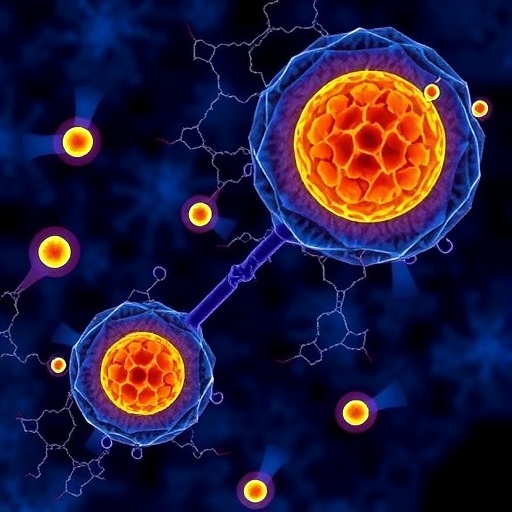In a groundbreaking advance poised to reshape our understanding of cholesterol regulation, a recent study elucidates the molecular orchestration behind the activation of sterol regulatory element-binding protein-2 (SREBP2) within the nucleus—a pivotal step in cholesterol biosynthesis and homeostasis. Long recognized as a membrane-bound transcription factor precursor, SREBP2’s journey from inert membrane association to an active nuclear entity has been studied extensively. Yet, the complex regulation of its nuclear transcriptional dynamics remained elusive until now. The newly unveiled mechanism centers on the formation of nuclear condensates driven by the intrinsically disordered region (IDR) located at the amino terminus of mature nuclear SREBP2 (nSREBP2), heralding a paradigm shift in nuclear transcription regulation.
The research highlights how, under cholesterol-deprived cellular states, membrane-anchored precursors of SREBP2 undergo precise proteolytic cleavage, liberating mature SREBP2 to translocate into the nucleus. Once inside, instead of diffuse distribution, nSREBP2 assembles into discrete nuclear condensates. These biomolecular assemblies arise from the amino-terminal IDR—an intrinsically disordered segment of the protein that fosters phase separation, enabling the creation of dynamic, membraneless compartments. Such condensates have emerged recently as critical regulators of gene expression, providing concentrated environments for transcriptional machinery and coactivators. This finding places nSREBP2 within the growing roster of transcription factors whose activity is modulated by phase separation processes.
Delving deeper into the biophysical underpinnings, the study identifies a highly conserved phenylalanine residue within the IDR as being crucial for condensate formation. Substituting this aromatic residue with alanine was shown to abolish the capacity of nSREBP2 to form nuclear condensates. The lack of these structures substantially diminished the transcriptional activity of nSREBP2 at its target lipogenic genes, signaling the essential nature of condensate formation for gene activation. This established a causal relationship between the physical state of nSREBP2 in the nucleus and its functional competency.
Remarkably, the researchers demonstrated the reversibility of this effect by fusing the mutant nSREBP2 to the IDR of FUS, a well-characterized phase separation driver. This fusion restored condensate formation and, correspondingly, the transcriptional output of nSREBP2. This creative molecular engineering underscored the specificity of phase separation as a mechanism rather than simple protein-protein interaction. The rescue experiment effectively decoupled the structural role of the aromatic phenylalanine from other possible confounders, cementing the argument that phase separation directly facilitates the transcriptional activation of lipogenic genes.
Functional implications of these molecular discoveries were substantiated through in vivo experiments with genetically engineered male mice carrying the phenylalanine-to-alanine knock-in mutation in SREBP2’s IDR. These mutant mice exhibited impaired feeding-induced activation of nSREBP2 target genes, underscoring the physiological role of nSREBP2 condensates in metabolic adaptation. Importantly, these animals showed decreased hepatic and circulating cholesterol levels, linking condensate dysfunction to systemic cholesterol imbalance. This phenotype reveals that the assembly of nuclear condensates by nSREBP2 is not merely a biochemical curiosity but a determinant of whole-body lipid homeostasis.
This study’s revelation redefines how a master regulator like SREBP2 exerts control over lipid metabolism. Traditionally, the focus was on membrane processing, nuclear translocation, and DNA binding in isolation. By delineating the formation of nuclear condensates as a critical regulatory step, the research integrates the increasingly appreciated principles of phase separation into classical transcriptional regulation frameworks. The nuclear condensate serves as a regulatory hub, bringing together nSREBP2, coactivators, and DNA elements to ensure a robust, coordinated lipogenic gene response.
The implications extend to the broader landscape of metabolic diseases, including hypercholesterolemia and atherosclerosis, where aberrant cholesterol management plays a central role. Pharmacological targeting of phase separation interfaces or the condensate formation process itself could emerge as a novel therapeutic strategy. Modulating nSREBP2 condensate dynamics might allow more precise tuning of cholesterol biosynthesis compared to existing approaches that interfere with upstream signaling or membrane cleavage.
Moreover, the identification of a single conserved amino acid—phenylalanine—central to condensate formation introduces a highly specific molecular target. Small molecules or peptides designed to mimic or disrupt this interaction motif could selectively modulate nSREBP2 activity without broadly affecting other transcription factors. This paves the way for next-generation interventions that control metabolic gene expression with unprecedented specificity by intervening at the level of nuclear condensate assembly.
Beyond cholesterol metabolism, this research exemplifies how intrinsically disordered regions in transcription factors act as functional modules enabling phase separation-mediated regulation. The concept is increasingly recognized in diverse contexts ranging from developmental gene regulation to stress responses. Studies like this propel our understanding of biological complexity by revealing how disorder and dynamic assembly create regulatory versatility in nuclear processes, transforming our grasp of gene expression control.
The study also opens new investigative avenues into the interplay between superenhancers and transcription factor condensates. While superenhancers have been implicated in high-level gene regulation, the physical mechanisms by which they coordinate with phase-separated transcriptional condensates remain underexplored. That nSREBP2 condensates partly localize on these elements suggests a cooperative model where condensates promote enhancer-promoter looping or concentrate enhancer-associated factors, boosting transcription efficiency.
Furthermore, this work highlights the potential for phase separation driven by intrinsically disordered regions as a widespread motif in metabolic transcription factors. Similar mechanisms may exist for other lipid regulators or nutrient-responsive transcription factors, suggesting a conserved evolutionary strategy for integration of environmental and cellular signals into transcriptional outcomes.
In conclusion, the identification of nSREBP2 nuclear condensates as facilitators of lipogenic gene activation represents a landmark in metabolic biology. This novel mechanism merges protein biophysics, gene regulation, and physiology into a cohesive model explaining how intracellular cholesterol levels dictate nuclear transcriptional responses. Future studies exploring therapeutic modulation of these condensates hold promise for combating metabolic diseases linked to cholesterol dysregulation.
This discovery adds a fresh dimension to the rapidly evolving field of phase separation biology, illuminating the intricate molecular choreography that underpins cellular homeostasis. As investigations progress, the principles uncovered here are likely to find resonance across diverse biological pathways, heralding a new era where biomolecular condensates are recognized as fundamental units of cellular regulation.
Subject of Research:
Regulation of cholesterol biosynthesis and homeostasis via nuclear condensate formation by sterol regulatory element-binding protein-2 (SREBP2)
Article Title:
Nuclear SREBP2 condensates regulate the transcriptional activation of lipogenic genes and cholesterol homeostasis
Article References:
Xu, M., Jiang, S.Y., Tang, S. et al. Nuclear SREBP2 condensates regulate the transcriptional activation of lipogenic genes and cholesterol homeostasis. Nat Metab (2025). https://doi.org/10.1038/s42255-025-01291-0
Image Credits:
AI Generated
Tags: biomolecular assemblies in gene expressioncholesterol biosynthesis pathwayscholesterol regulation mechanismsintrinsically disordered regionslipid gene activationmembraneless organelles in cellsnuclear SREBP2 condensatesnuclear transcription regulationphase separation in proteinsproteolytic cleavage of SREBP2sterol regulatory element-binding protein researchtranscription factor dynamics





